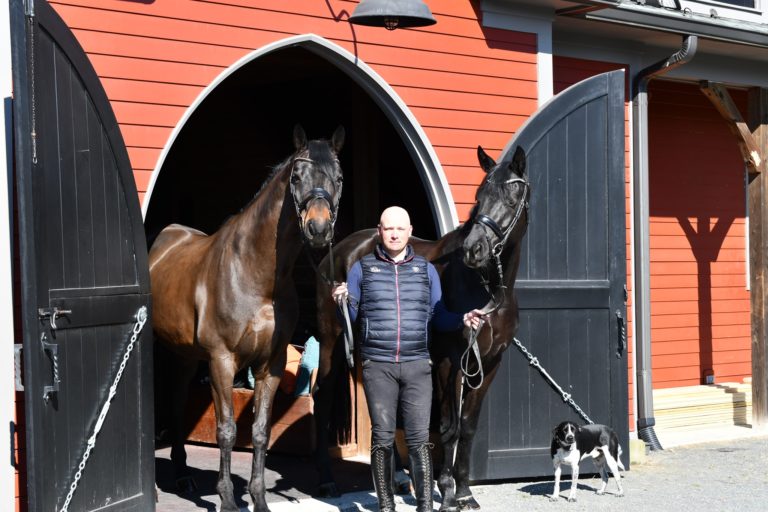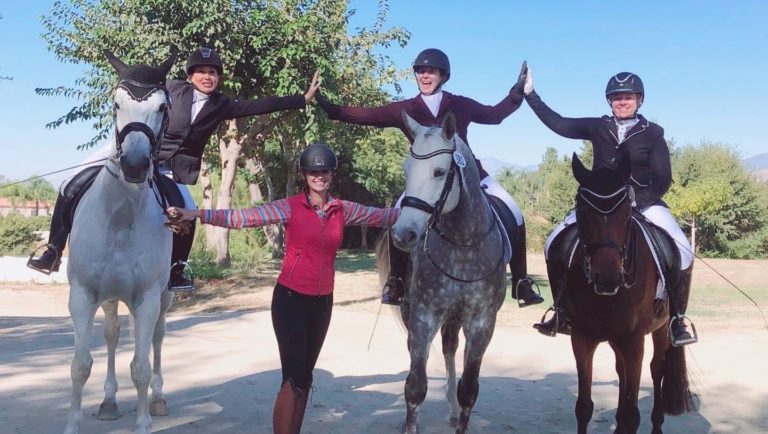Now that we have brought awareness to our torso, this month we are going to look at leg stability. When you ride, your legs should stretch down to help anchor your pelvis. They should rest against your horse’s side like wet towels, breathing with him and ready to give a stronger aid if necessary. Good control of your leg creates clearer communication with your horse. You need to be able to apply appropriate leg pressure whenever you want. Your thigh should be snug against the saddle, but not restrictive, with your knees and toes pointing forward.
Too strong a leg and your hips, knees and ankles become locked, leading to possible tightness or even injury that results from reduced shock-absorbing ability. Your horse can also become tense and his breathing restricted. In this position, there is no leeway for you to give a clear aid, as your legs are already pressed hard against your horse’s sides. Too loose a leg and you will lose stability in your pelvis. Constant involuntary leg aids will cause your horse to become dead to your leg and eventually ignore it altogether. Your leg will also lose effectiveness as it becomes sloppy with a lifted heel and no remnant of positive tension. In this state, there will be no inside leg for your horse to bend around on a circle and no outside leg to guard against swinging hindquarters.
Riders often use too much of their gluteus maximus and external hip rotator muscles, which leads to legs that would be better suited to a frog than a horse rider. This, as well as overuse of the muscles on the inside of the thigh, the adductors, pushes the seat bones out of the saddle. Relaxing your buttocks and getting better control from the gluteus minimus and the anterior fibers of the gluteus medius help to lower your center of gravity and allow your seat bones to sink into the saddle. This aids a deep seat while keeping your leg in a slightly internally rotated position and still allowing your lower leg to give aids.
To see how well your gluteus medius and minimus muscles help you ride, begin seated in the saddle. Maintain a slight bend in your knee and external rotation of your lower leg, allowing for an approximately 30-degree turn out of your foot. Take your legs away from your horse at your hip, rotate them in and extend them back before replacing them against your horse’s sides.
These exercises will help you switch on the required muscles to help control your legs without disrupting the balance and stability of your torso achieved by previous core exercises.
Diagonal-Line Clams
This exercise will help you find your gluteus minimus muscle and the anterior fibers of your gluteus medius at the side of your seat, which will help you lift your legs off the horse and internally rotate them. When the exercise is executed slowly and with purpose, your muscles will gain the ability to control and support your hip joint. Make sure your knees remain stacked, as it is often easy to let your top knee roll behind your lower knee, but you must avoid this serious misalignment.
Setup:
- Lie on your side with your knees bent at a 45-degree angle. Rest your head on your lower hand with a bent elbow. Make sure there is a little space under your lower waist to ensure your hips and knees remain stacked while keeping your ribs connected to the ground.
- Add lateral breathing, inhaling through your nose and out through your mouth. Switch off your global muscles and switch on your core.

Credit: Norma Ashton

Credit: Norma Ashton
Instruction of Movement:
- Breathe in and touch your top knee to the ground, just in front of your lower knee with the top lower leg aligned on a diagonal line heading slightly behind your body. Your entire top leg should be slightly internally rotated from your hip with your top foot flexed.
- Breathe out and slowly straighten your top leg. Maintain resistance, feeling as if you’re pushing something heavy away with your top foot. Keep your hips stacked and maintain the internal rotation of your leg. You will find at the top of the move, your leg has reached a dressage position. Breathe in at the top of the move and breathe out to resist slowly back to start.
- Repeat 10 times, then switch sides.
Seated Pigeon Stretch
If your toes stick out when you ride, your lateral rotator muscles might be too tight. This exercise will help stretch them out, making it easier to find your internal rotators in the exercise above.
- Sit with your knees bent and hands supporting you behind, with fingers facing toward you. You may also prefer to sit against a wall.
- Cross one leg over the other so that your upper leg is supported by the opposite knee. You should feel a stretch in the back of the buttock of the leg that is crossed.
- Rock side to side until you find the tightest muscle fibers and hold the position there for a few breaths. Repeat on the other side.

Credit: Norma Ashton
Rebecca Ashton is a qualified Pilates instructor, a British Horse Society-trained instructor and an Equestrian Australia-accredited dressage coach. She has competed through Intermediaire II, working with riders such as Anky van Grunsven and earning championship titles in the small tour. She lives in Australia and teaches clinics internationally (equestelite.com).











